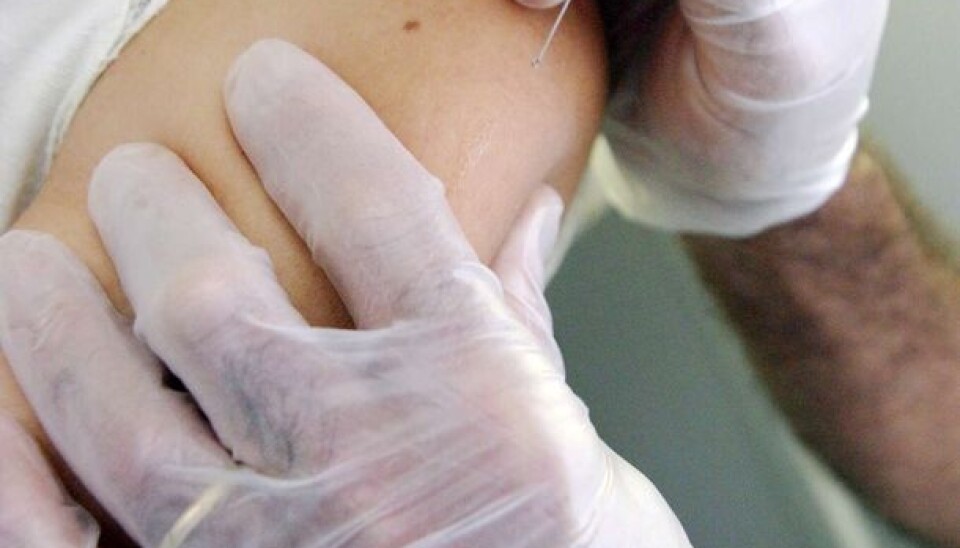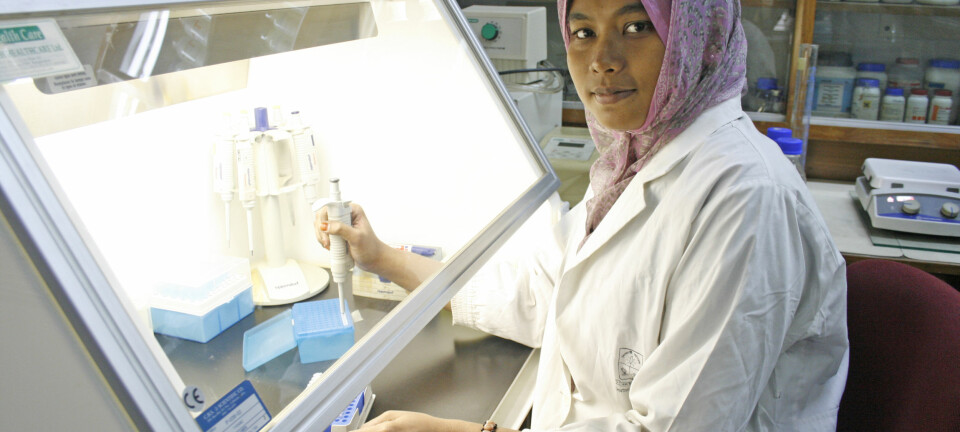An article from University of Oslo

'We need to develop new vaccines'
Scientists are in a constant arms race against pathogenic bacteria and viruses. Their goal is to develop vaccines that will last throughout our lives.
Denne artikkelen er over ti år gammel og kan inneholde utdatert informasjon.
It is over 30 years since smallpox was declared to have been eradicated.
The dreaded disease struck ruthlessly and indiscriminately, with ensuing high mortality.
The use of vaccine enabled us to wipe out the virus, which today can only be found in a very few research laboratories.
Changed risk picture
The frightening diseases that inflicted abscesses and paralysis on humans have practically been eradicated, at least in the Western part of the world.

Today, in contrast, it is the influenza virus that plays a major role in the risk picture. How well prepared are we to withstand a possible pandemic?
“We are about as well prepared as we were when swine influenza appeared,” says Bjarne Bogen.
He is professor of immunology at the Institute of Clinical Medicine at the University of Oslo, and his work is concerned with creating the influenza vaccine of the future.
The mutated virus evades the vaccine
The influenza virus is changing all the time – at a swift pace. Since the influenza virus mutates so quickly, it evades the vaccine. Vaccine and immunity one year do not necessarily provide protection the following year.
“We need to develop new vaccines. Today we must continuously revaccinate. Our goal is to develop a vaccine that will last throughout our lives,” continues Bogen.
Much of the research into vaccines is concerned with the triggering of immune responses, i.e. bringing about specific reactions from our immune system.
Researchers have found antibodies that have a broadly neutralising effect on influenza. These antibodies combat the virus, and when they have a broadly neutralising effect they are efficacious against several variants. The recipe for success is to design a vaccine that triggers these antibodies so that the correct response is initiated in the immune system.
However, it is difficult to make vaccines for the entire world population. Traditional vaccines are cultivated in eggs, and there are simply too few eggs to make vaccine for everyone on the planet.
In addition, the production time can cause problems. In the event of a new pandemic the virus must first be typed in order to develop a tailor-made vaccine.
At present a vaccine cannot be prepared beforehand because no one knows what kind of virus will strike.
The virus’s Achilles’ heel
Researchers are also searching for a preventive vaccine against HIV.
After a number of years some individuals who are infected by HIV develop antibodies that give protection against the virus. The antibodies appear to bind the virus in a special way.
“We want to create vaccines that will enable us to trigger these antibodies in advance,” says Bogen. “The body will then be armoured against HIV when the virus attempts to invade.”
HIV mutates extremely quickly
“We see more variation in one single individual with HIV than we find in influenza in the entire world throughout time,” Bogen points out.
How then should the virus be destroyed?
“The crucial factor is to target the virus’s Achilles heel,” says Bogen.
The idea is to trigger an immune response to something the virus must exploit to be effective. In the case of HIV one component of the virus is absolutely essential in enabling it to penetrate cells. If the antibodies produced bind themselves to this component, the virus cannot mutate. The antibodies have homed in on the Achilles’ heel.
Diseases can flare up
“Vaccination is one of the most effective forms of prevention available,” says Marianne Riise Bergsaker at the Norwegian Institute of Public Health.
In Norway, there is a separate vaccination programme for children. More than 90 percent of all the cildren are vaccinated.
"That means that most parents choose to vaccinate their children. However, some people still refrain from doing this for various reasons,” says Bergsaker.
Since different vaccines have been included in the programme, the incidence of diseases has been drastically reduced. Some of the diseases have more or less disappeared.
Nevertheless – without vaccination, the diseases return.
“As long as a disease has not been eliminated, we are dependent on vaccinating every new cohort of children,” says Bergsaker.
If not, the diseases can flare up once more.
“We have examples of this from other countries where vaccination coverage has diminished, and diseases such as measles, diphtheria and poliomyelitis are flourishing once again,” Bergsaker says.
One for all and all for one
Some of the diseases we are vaccinated against are easily transmitted from person to person. When many people are vaccinated, very few of the population are susceptible to infection. This is bad news for bacteria and viruses. As a result, they do not gain a foothold in the population so there is little transmission of the bacterium or the virus.
“Thus the risk of infection is also reduced among those who are not vaccinated. This is referred to as herd immunity,” Bergsaker explains.
But herd immunity does not always help.
Bacteria are not only passed on from person to person, but also have other routes of transmission. This applies to tetanus, for example. The bacterium that causes tetenus, Clostridium tetani, is found in the soil and can enter the body through breaks in the skin. The only protection against the bacterium is vaccination.
For other diseases including measles, those who are not vaccinated are at high risk of infection and can develop the disease if they are exposed to the virus or the bacterium in question, for example when on holiday abroad.
Weaknesses of the BCG vaccine
Vaccines undoubtedly save lives, but some of the vaccines have considerable limitations. One example is the BCG vaccine, which protects against childhood tuberculosis.
Infectious diseases remain a serious problem in large parts of the world. Even though in Norway the sanatorium full of patients infected with tuberculosis is a thing of the past, tuberculosis is still the cause of one million deaths annually in other parts of the world.
The BCG vaccine protects against serious childhood tuberculosis. But it does not give protection against being infected nor against pulmonary tuberculosis in adults, which is the type responsible for the spread of the disease.
“Therefore the BCG vaccine does not prevent the spread of the disease in the population,” explains Professor Bjune of the Institute of Health and Society. He is carrying out research on global health and infections.
Under control
Now and again we hear about people here in Norway who are infected with tuberculosis. Is the disease making a comeback?
“No,” says Bjune, who believes that it would be wrong to warn of a resurgence of tuberculosis.
Last year there were approximately 400 new cases of tuberculosis in Norway. People from countries where tuberculosis is widespread represented 80 per cent of these.
“There is almost no proof of infection after arrival in Norway, and treatment has restored the health of those who are infected,” says Bjune.
Even though tuberculosis is effectively controlled in Norway, the situation is very different in large parts of the world. But on the bright side, the severe pandemic that we saw from the middle of the 1980s is now levelling out. At the same time multiresistant bacteria have not spread as much as feared.
All vaccination entails some risk of adverse effects
“Fortunately side-effects are very rare and the positive impacts of vaccination outweigh the negative,” Bogen asserts.
“There are strong grounds to believe that vaccination is useful and gives us protection. Therefore as long as these diseases exist, it is crucial that people get vaccinated.”
------------
Read the Norwegian version of this article at forskning.no




































